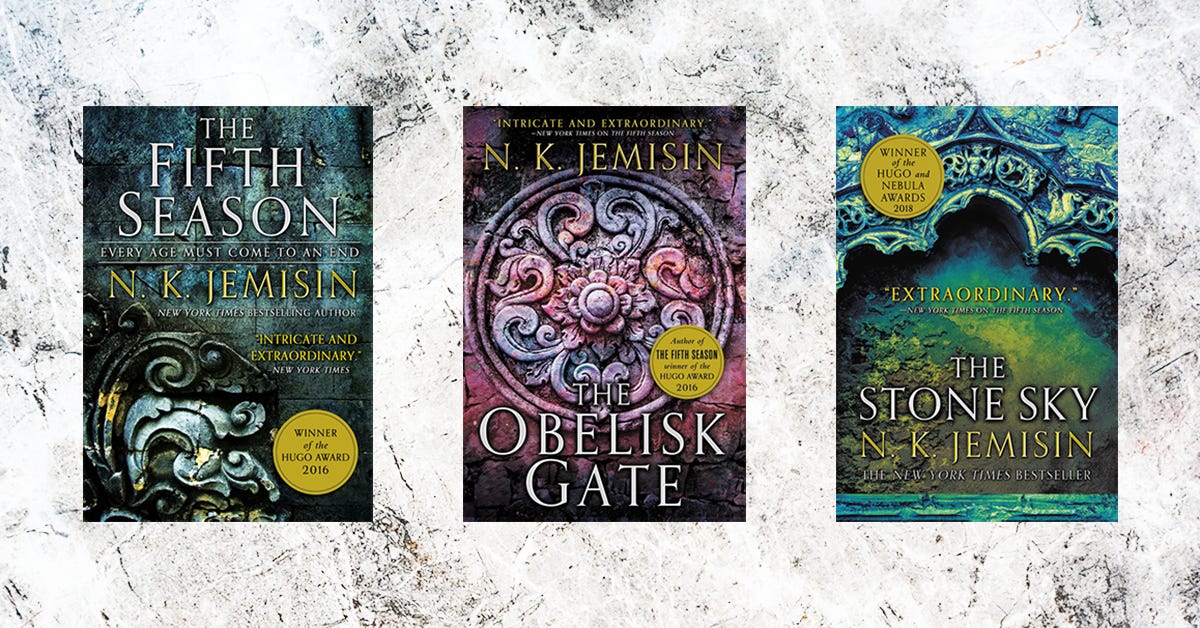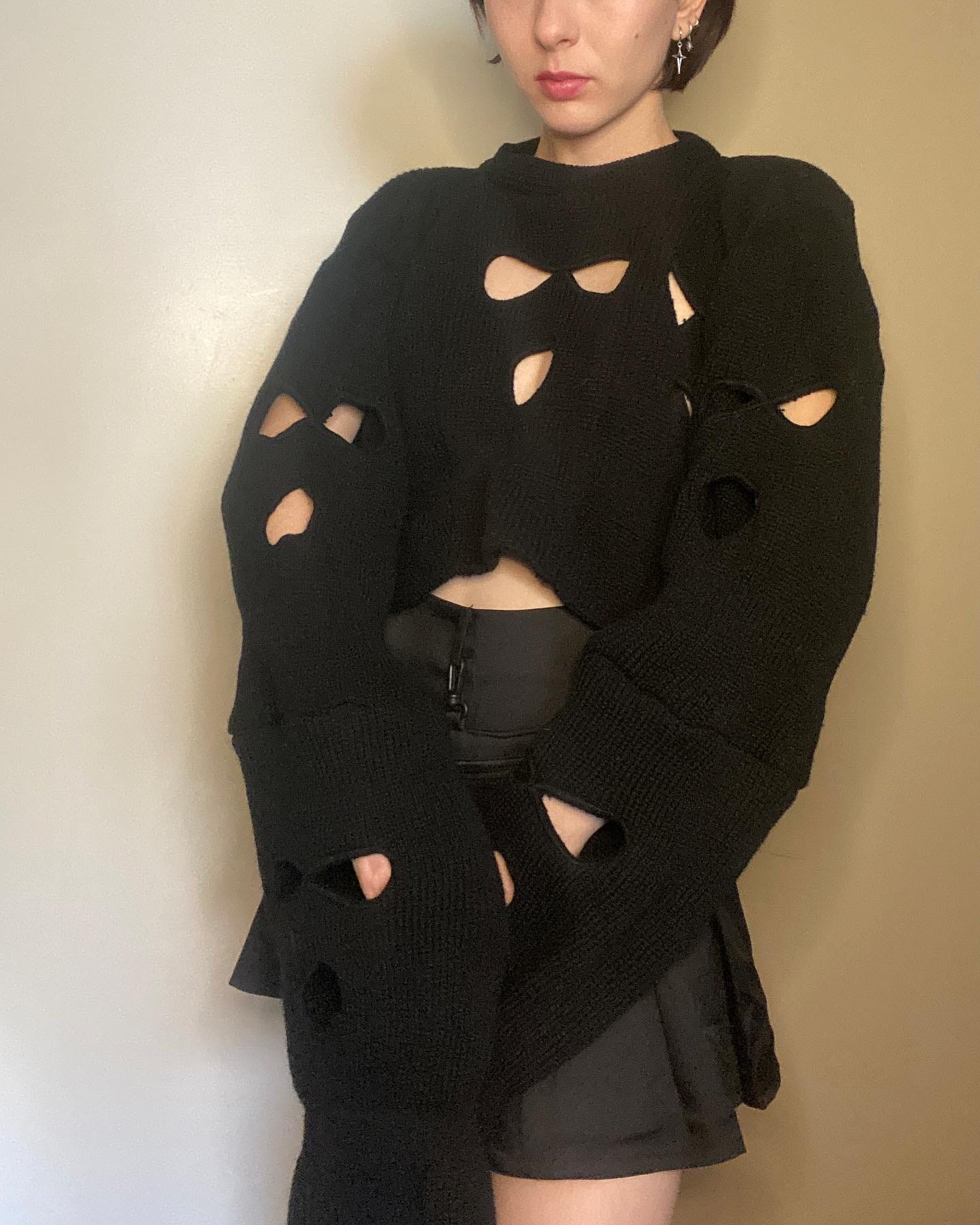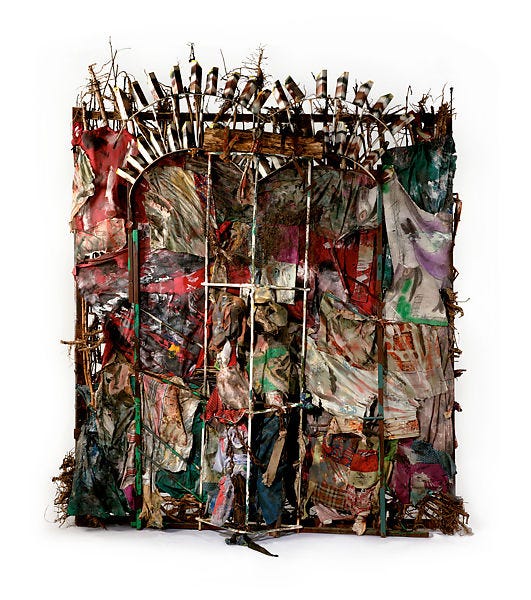Hello friends!
It’s been a busy time, to say the least. Between my birthday, my job picking back up again, and an unexpected housesitting stint, I am perplexed at how this usually bleak, slow time of year became an endless series of to-do lists. This doesn’t mean that I’ve stopped reading, listening, and watching, I’m just too tired at the end of the day to articulate my thoughts.
Maybe it’s because I’m deep in a crochet, polymer clay, crafty TikTok clickhole, or because of gifting during these festive times, but I’ve been thinking a lot about things lately. I began to take better stock of the textures, materials, objects, fabrics I like to surround myself with this past year, listening to my own curatorial instincts. I’ve been trying to think about it as materialism with purpose, less about buying new stuff and more about tuning into and shaping my own ideal sensory environment.
This is a newsletter about thingness, I guess.
TOUCH
I blazed through N.K. Jemisin’s Broken Earth trilogy this past week. The power in her world is an alchemical ability called ‘orogeny’ that can manipulate the magma and rock under the Earth’s surface. On this continent, plagued with seismic activity and apocalyptic ‘seasons,’ we follow the tumultuous life of one orogene as she survives harsh training to control her abilities, an awakening of ancient powers, as well as the murder of her son and the abduction of her daughter. This synopsis does not even begin to encompass all of the complex themes of dehumanized otherness, systematic racism, motherhood, and climate change that thread throughout this series. It’s a harsh, unforgiving epic world that presents bodies as tools and weapons, malleable like carved stone.
I decided to treat myself to one of these amazing ski mask sweaters by Lasher Felix. These cultural symbols of crime and cold weather are rearranged into a wearable new purpose. With the oversized sleeves and funky pattern of cutouts thanks to the masks’ eye and mouth holes, every time I put this on I feel like I’m in a computer hacker action thriller from the early 2000s.
In a recent trip to the New Museum, I got to see Daiga Grantina’s wonderful draping sculptures. Aptly titled, “What Eats Around Itself,” the Latvian sculptor’s pieces are in a suspended state of cannibalism. Inspired by the decompositional properties of lichen and fungi, Grantina builds up poetic biomorphic drapings of fabric, silicones, and latex. Weaving around these floating fruits of decay and fabrication, you can’t help but feel like you’re wandering through a forest in some far-off planet.
LOOK
Thornton Dial’s colorful assemblages are not only accumulations of found objects and repurposed scraps, but textured collections of American history. Originally working as a metalworker in Alabama, Dial built up a body of artwork that reckons with racism, poverty, and social violence in everyday life. Take for instance his 2004 sculpture, History Refused To Die (pictured above). Constructed out of okra stalks, clothing, steel chains, and spray paint that explores the transatlantic slave trade’s impact on African American genealogy and heritage through cuisine.
I’ve been following photographer, video, and collage artist Savana Ogburn on Instagram for years now and I am always left in awe of their brilliant creations. Their colorful set design reminds me of those rainbow kaleidoscope toys you’d get at carnivals as a kid, a visual feast of delicious textures and ethereal shine. Each campy array of images feels like a cut-up zine come to life, with odes to 1980s extravagance and over-the-top Hollywood movie monsters. Ogburn has photographed iconic drag queens, dabbled in medieval fantasy, and they are an absolute marvel when it comes to self-portraits. You can check out more of their amazing work on their website.
Speaking of unforgettable textures, I would be remiss if I didn’t talk about sculptor Tara Donovan. Donovan’s materials of choice include sliced-up pencils, Styrofoam cups, acrylic tubs (like the 2014 piece above that resembles giant dandelions), and even Slinkys. Donovan’s monumental pieces are pure tactility, creating mutated patterns through an accumulation of everyday objects. In a 2015 interview, Donovan shared her process, “There’s a beauty to these ordinary objects, elevated and shown and highlighting a texture that you may not have realized at first...A lot of times, they start in really simple places, like Staples or the grocery store.” In a time dominated by industrially-made goods, Donovan’s work reminds us to appreciate the everyday.
LISTEN
Every year, 99% Invisible releases an episode about bits of design history that their team learned about in their research, but couldn’t turn into a full-length episodes. Their 9th, 10th, and 11th iteration of Mini Stories certainly doesn’t disappoint. From the reason why old radiators are so noisy to the invention of space pens and ghostwriting movie novelizations, all of these objects stories are strangely fascinating.
I've been thinking this interview with prolific assemblage artist Betye Saar, preserved through the Getty’s wonderful podcast of archival interviews between artists and curators. Each of her sculptural pieces are like little time machines, full of collected objects that challenge racist and sexist imagery (like the ‘Mammy’ figure), explore mythology and the occult, and entangle pop culture with her own familial history. Saar’s interview dives into the discrimination she’s faced in the art world and about her Californian identity, but I also appreciate how this episode includes commentary by artist Linda Goode Bryant and art historian Marci Kwon reflecting on the historical period and the way the Getty’s own curators may have missed the mark in their analysis of Saar’s work to her own Black womanhood.
Nothing feels like winter quite like Laurel Halo’s 2018 album, Raw Silk Uncut Wood. It’s a brief, yet gorgeous collection of ambient tunes that feels a bit like opening up a window on a cold February morning to get some relief from your overheated apartment. Falling somewhere just on the other side of ASMR, her abstract melodies, punctuated by sensuous organ tones, are like little glowing pieces of sonic poetry.
LICK
I recently watched the 1988 iteration of The Blob. I won’t lie to you, I was expecting something bad—something absurd, kinda campy, in a so-bad-it’s-good style that’s characteristic of most cult classic horror films. I ended up loving the gooey, fleshy special effects and the genuinely terrifying death scenes. It’s such a ridiculous concept: a meteor crashes, unleashing a fast-growing predatory microbe on Small Town USA. You’ll have a lot of fun watching this (although slimy things might make you squeamish for a few days after).
I am obsessed with the Instagram account thundergirl_xtal. Katya, the elusive artist behind these photos, turns ordinary foods and plants into unsettling acts of body modification. Mundane moments of daily life, like your skincare routine, putting on makeup, or painting your nails, become wonderfully grotesque under her creative eye. Katya has spoken very little about her work publicly (her mysterious and surreal feed speaks for itself). Yet, in a conversation with Vogue Italia, she says she began her project as “my exploration of corporeity” and that “I became interested in the topic of anonymity and I began to study how face concealment works and what place it has in the cultural code.”
Mira Dayal’s a scroll, a wall, an island is one of my favorite iterations of the email-only art ‘exhibition space,’ Screen_. It’s a profound meditation on historical being and materiality. Her poetic text tumbles down scans of torn paper and crinkled plastic. Dayal writes, “plastic / wraps / traps the residues / tracks the avenues / of that history / halts its progress / impresses sterility.” You could spend hours scrolling through this piece, examining the minutiae of each scanned rip, each textual mountain and valley. If you’re in New York City, you can also check out Dayal’s topographical installations at Spencer Brownstone Gallery.
Lastly, a video for you: Nowness’s interview with artist Raúl de Nieves for their Raw Materials series. He shares the influence his Mexican heritage had on his creative development, including learning to crochet and sew at a young age, and how that manifested into a fascination with the bacteria-like qualities beading following a trip to New Orleans during Mardi Gras. In these acts of repetition, of reusing the same material or recreating the same image again and again, de Nieves elevates these mundane discards into a search for spiritual revelation.
CLICK
Kate Washington’s essay “Your Extra Stuff is a Feminist Issue” is such a refreshing challenge to the trends of minimalism that remain dominant in the social media spheres (usually to the benefit of white, skinny, wealthy women). From the emphasis on dieting to ‘reduce’ the body to the popularity of decluttering strategies that deem keeping goods as ‘sinful,’ Washington writes, “In a culture of plenty, paring down is a hard-to-achieve status symbol. Getting rid of both so-called extra flesh and extra stuff is a burden falling disproportionately on women.”
“Object Permanence” by Nicole Sealey is one of those poems I read for the first time and left it feeling utterly breathless. It’s such a tender poem, beginning with lovers waking in golden morning light and ending with caterpillars stuffed with milkweed. In honor of recently-passed Valentines Day, a sweet sample: “There’s a name for the animal / love makes of us—named, I think, / like rain, for the sound it makes.” It’s something more than just another silly little love poem, aching with revelation.
What does it mean to think of language as a material? Not just something of sociocultural importance, but as something with a very physical presence in our reality. There’s this great excerpt from Ilse Aichinger’s short story collection, Bad Words, that imagines this very situation, language as a kind of pet or companion to the author. As Aichinger’s protagonist attempts to set up a picnic for her language near some customs officers. She observes, “They find my language suspicious, not me...My language didn’t touch what I put in front of it—it lets sea foam salt its food.” Aichinger wrote about the Nazi persecution of the Jews oftentimes through parables, contemplating the acts of othering by German government officials.
I can’t talk about poetry and language and materiality without talking about H.D. She is considered one of the pioneers of the Imagist style—a modern reaction to the flowery style of Romanticism through simplified language and sharp, clear visual studies of objects and bodies. H.D.’s “The Garden” is a lush example of this technique, wielding punctuated rhythms of repetition with precise authority.
I recently revisited Emily Spivack’s New York Times column, “The Story of a Thing.” Spivack spoke with artists, celebrities, architects, designers, and culture-makers about a particular object that has shaped the way they approach their creative work or impacted their life trajectory. Although the column ended in 2019, it’s such a great archive to scroll through if you’re looking for inspiration and intimate storytelling. Some of her subjects include singer Angel Olsen’s leather satchel, chef Alice Waters’s ceramic collection, and artist Susan Cianciolo’s daybed.
It’s been a long time since I stepped inside a thrift store so reading Ted Kooser’s “In the Basement of the Goodwill Store” filled me with such nostalgia for the hours spent combing through the racks, trying on clothes with friends, and marveling at the kitsch people left behind. Kooser taps into this odd intimacy that comes with thrifting, the familiar faces, encountering objects that once had emotional significance to someone. Kooser writes, “you too will look down over the years, / when you have grown old and thin / and no longer particular, / and the things you once thought / you were rid of forever / have taken you back in their arms.”
Thanks for taking the time to read! Feel free to share this little project of mine with your friends, lovers, and enemies. If you like what I do, you can help feed my leopard gecko through Ko-Fi or check out my website. You can find a list of books by the people I mentioned on Bookshop (I get a small commission through this and any Bookshop affiliate links in this letter).
Until next time,
Ellie













